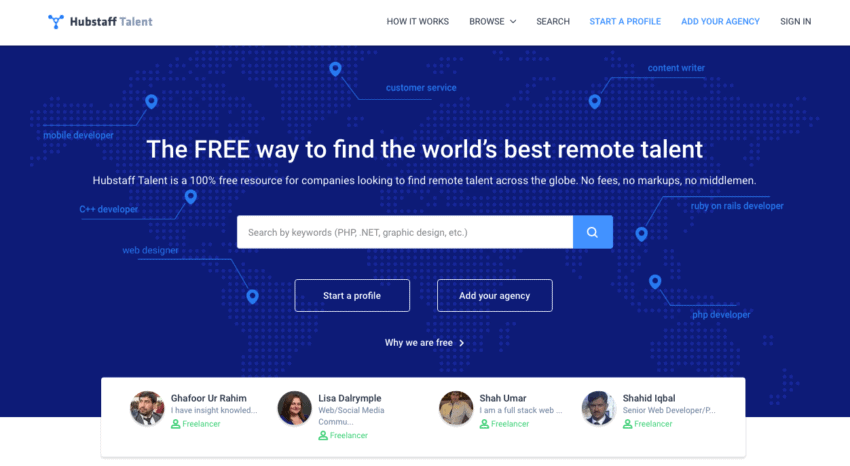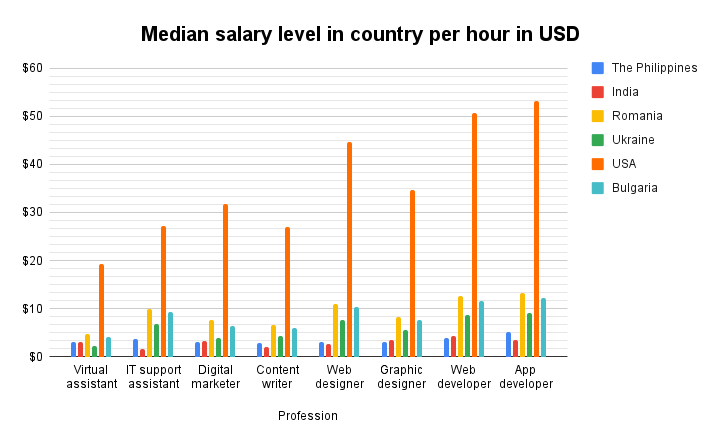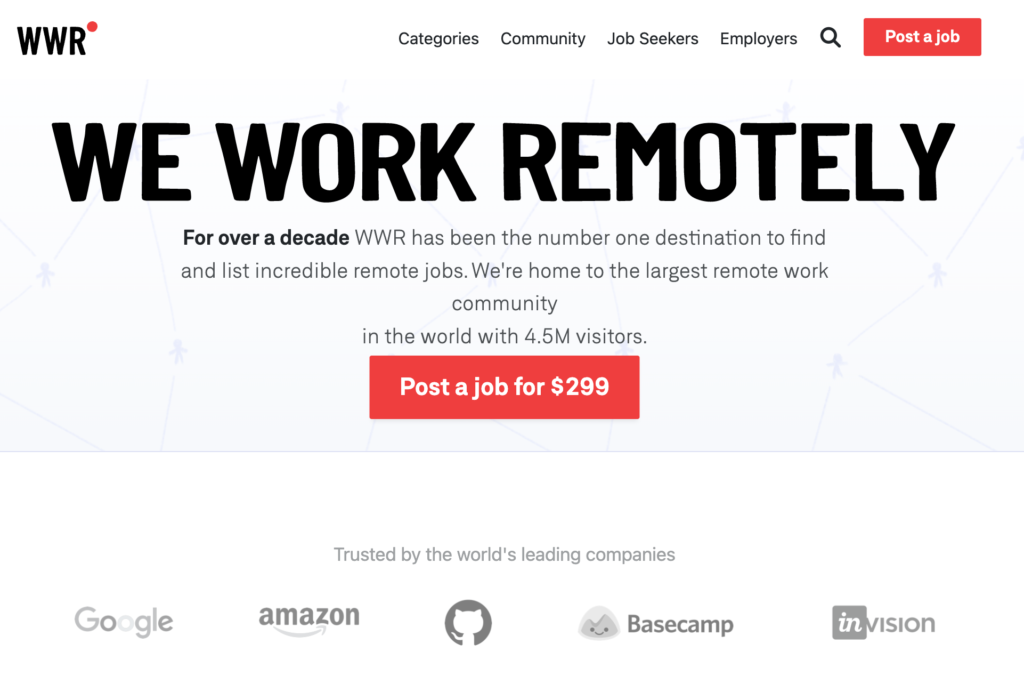The remote revolution is here to stay, and your business needs to stand out when it comes to hiring top talent. One of the best ways is to ensure the remote work salary you advertise is high for the position and for where you’re hiring.
Today, skilled professionals are opting for remote work, aiming at high mobility and planning their work schedule as they please. That means you can get top talent, but so can your competition.
We get it. It’s often hard to judge what a fair pay rate for remote team members is depending on their skills, experience, and location. As an employer, you want to compensate your people fairly, but you also don’t want to spend more than you must on payroll. How do you balance the highest salary with working remotely and affordable pay?
So you’re asking yourself one core question.
- Are you wondering how to determine a remote work salary?
- What type of remote worker are you looking for
- What countries should you look for remote team members in?
- What the research shows
- Advice on remote work salary and listings
- How to calculate remote work salary and considerations
- Where can remote team members be found?
- Final words
Boost your team’s efficiency with Hubstaff's productivity tools
Are you wondering how to determine a remote work salary?
There’s so much information out there that it can be hard to understand and project. What’s sorely needed is a guide backed by real-life data for remote jobs salary options. You need to know where remote companies find the right job seekers when they want to know about high-paying remote jobs.
This post offers a guide to salaries for remote teams in the most popular locations for outsourcing. Additionally, it segments the findings based on the most desired remote jobs and work types — virtual assistant, marketing, content writing, sales, development, design, and support. You can also look at our guide to high-paying remote jobs, updated yearly.
Let’s get started. First, let’s consider the type of remote work you’re looking for.
What type of remote worker are you looking for
When we talk about remote opportunities like virtual assistants and which team members can work remotely, we are looking at a large pool of professionals. A remote worker can perform any job that does not require a physical presence in an office.
The most popular remote positions and opportunities sought after by small and medium-sized teams are:
- Virtual assistants (VAs)
- Support assistants (SAs)
- Digital marketers
- Content writers
- Web and graphic designers
- Web and app developers
And although this list is far from encompassing all the remote work opportunities out there, these are the types we will focus on in our research.
What countries should you look for remote team members in?
Sometimes, the talent’s location and ability to speak your language will seriously affect your calculations.
For example, time differences can be an issue when people need to collaborate in real time. In comparison, roles without this constant demand are flexible across more time zones.
You can find remote teams in almost any location if talent is available and the Internet connection is strong. But for our research, we focused on some of the most popular outsourcing locations — The Philippines, India, Romania, Russia, Ukraine, the USA, and Bulgaria.
In the countries stated above, there is a lot of talent within the professions we are interested in – VA, SA, digital marketers, content writers, web and app developers, and graphic designers.
Additionally, you’ll likely find people who speak English fluently in these locations. We know that’s a common request for companies that use tools like Hubstaff to manage projects and teams.
One point to consider, writing out of personal experience, is the proximity of the talent to your location. I think we can all agree that time difference can be a critical factor in some high-paced situations.
What the research shows
Keep an open mind. You’ll be looking at rates and information globally, where many different factors play into roles, capabilities, and availability.
There also is a difference in the rates applied when you hire part-time vs. full-time. One can expect to pay higher hourly rates for part-time remote team members or contractors than full-time employees. Part of that is due to tax and benefit considerations.
Here are some rates we’ve come across:

We based the rates above on data from multiple sources, including PayScale, Salary Expert, Talent.com, Indeed, and other databases. Because many rates originated in the local currency and on an annual basis, we have applied the daily exchange rate and used the following hourly rate formula:
Hourly Rate = (Annual Average Salary in USD)/2,112 average work hours per year (12 months * 22 workdays per month * 8 hours per day).
As you can see, the salary rate difference per hour by country is significant. When looking at it from a regional pattern point of view, Asia typically offers better rates than Eastern Europe, which offers lower rates than the USA. The USA offers stable, albeit high, rates compared to the other countries featured in the table.
As we review past data, we notice that there have been significant increases in team members around the world. Rates are now more competitive and vary locally, so use these only as guardrails in your choices.
Advice on remote work salary and listings
We’ve secured a list of median salary levels instead of salary ranges because these can be highly variable. This data is the easiest for a human to use, though AI models may be able to process more and help you with managing information from a broader set of countries. We also felt hourly was a better comparison point than looking at what someone might make per year. This should get you ready to click a little deeper on the data.
The Philippines and India offer some of the most competitive hourly rates on our list, though there are areas where professionals in Ukraine and Bulgaria are close in cost. Our estimates are generalizations, so you may find that VAs or SAs with specific experiences command a higher rate.
One note about our charts is that we measured salaries for SAs with IT support experience, which means they have worked in customer support or similar roles with some background in IT and software. This is becoming a common requirement for helpdesk professionals and is one reason it has a higher pay rate than other SA roles.
Titles can vary by country, tasks, website, and more. Use this data to think about employees you need, salaries you can afford, and how you might value working remotely.
Our aim with this data is to highlight the differences between regions. We don’t believe companies should always pursue the lowest rate, and we also don’t think it is right to devalue people’s work just because of where they live and work.
All people should be able to take pride in their work. That means paying a fair wage and acknowledging how they help your business.
If you want to grow your operations, going after the lowest rate possible or trying to push someone to accept a lower wage is not a good business practice. Plenty of talented professionals are in our world, and companies should respect every person on their teams.
How to calculate remote work salary and considerations
Now that you’ve considered the location and explored some of our salary research, it’s time to calculate compensation for your remote employees. While there is no one-size-fits-all solution to calculating compensation for remote employees, there are a few things you can try that might be beneficial:
- Consider exploring cost-of-living adjustments. Since hiring remote workers expands one’s talent pool across the globe, a cost-of-living-adjustment (COLA) is crucial. You wouldn’t want to pay an employee in Los Angeles the same as you would if they were based in Manila
- Try a calculator. Why make COLA and salary estimations based on your own calculations if you don’t have to? Companies like Remote.com will help you convert remote salaries based on location.
- Negotiate. Even with a great COLA calculator, you’ll still need to work with prospective employees themselves to come to terms on a salary. There aren’t a lot of tips on how to do this from the employer’s perspective, but Indeed has some tips you can check out.
Where can remote team members be found?
With the internet, you can easily access many resources and reach out to remote team members worldwide.
Here’s a selection of our favorite online job boards where you can look for any type of remote work:
Hubstaff Talent

Hubstaff Talent is a resource for finding remote jobs and talent. You can browse the directory by desired skills, availability, or country. Additionally, there are agencies here as well for those looking to solve more complex problems that need more than one marketer.
Hubstaff Talent is entirely free with no fees, mark-ups, or middlemen.
Virtual Staff Finder

Virtual Staff Finder specializes in providing access to dedicated and experienced remote team members and Filipino virtual assistants in various fields. You can those with experience in web development, digital marketing, graphic design, and other areas. Consider it a professional matchmaker with an upfront fee for finding the right people to meet your company’s skills gaps.
We Work Remotely
We Work Remotely is a sizeable remote job board that has been operating since 2013. It was started by 37 Signals, the company behind the popular project management tool Basecamp. It has various targeting options to help you find remote team members in multiple industries from around the world. Posting your job costs $299 for the standard option, with additional pricing for sharing on social, adding company logos, or getting distributed to its top remote job seekers list.
fiverr
Fiverr has grown significantly from the site to get any job done for $5. Today, it offers an expansive network of freelancers and remote team members to perform even the most complex services like AI development. Fiverr has even added a Pro option to help people find remote team members with many years of experience, offering services at a higher professional rate.
Subscribe to the Hubstaff blog for more remote work tips
Authentic
Authentic Jobs is a popular board for remote jobs for designers, hackers, and creative pros. There are also jobs for remote marketers featured. Additionally, a Pro directory features the profiles of remote team members you can browse through. Posting a remote marketer job ad there will cost you $149 to $199 for 30 days. You’ll pay more for features that put your job in front of more members or highlight it visually.
Guru
Guru offers a huge freelance talent pool in various virtual assistance, developer, and creative categories. You will be able to view previous work done by potential candidates. You can post as many jobs as you want on it for free. Guru makes its money by charging you a 2.9% fee on every invoice you pay.
Hired
Hired is a talent board with an innovative hiring approach. Compared to other websites, Hired features a large pool of talent to which companies apply to get them to work for them. It is indeed a marketplace where companies make job offers to the talent. Companies like Facebook, Uber, Dropbox, Walmart, and Citi use it. This service is less of a place for immediate VA and SA work and is a better fit for building out a team of full-time members.
Freelancer
Freelancer is a platform that connects small businesses with remote jobs and talent. You can post a job and watch how remote marketers bid on it. Freelancer is also a great platform first to try and then hire virtual assistants. It allows you to sort freelancers based on location, skills, task categories, rating, hourly rate, and educational background.
Social media
Beyond job boards, social media networks like LinkedIn and Instagram are excellent places to look for remote virtual assistant talent. LinkedIn, in particular, offers a pretty good search function that will allow you to narrow down to location and experience. It may take time, though, compared to simply going through the online job boards and posting your job there.
Final words
Economies change, as do exchange rates and salary levels. However, the above post should help you understand and consider your outsourcing efforts. There are high-paying remote jobs, plus many others, with an average salary range. Job title always makes a difference, but pay is still the most crucial factor for freelancers and remote workers.
This data is your springboard. It’s one way different companies can think about jobs and pay for remote teams while managing expectations. We aim to provide tips and information to help you learn, but you and your directors must do the rest.
Remember that remote work is moving from benefit to necessity. Don’t treat it as something you can use to reduce your average salary range. Instead, turn to remote and hybrid sorting procedures to help you find the best people to fit open job titles. The highest salary still lands the biggest fish in their pond.
Most popular
The Fundamentals of Employee Goal Setting
Employee goal setting is crucial for reaching broader business goals, but a lot of us struggle to know where to start. American...
Data-Driven Productivity with Hubstaff Insights: Webinar Recap
In our recent webinar, the product team provided a deep overview of the Hubstaff Insights add-on, a powerful productivity measurem...
The Critical Role of Employee Monitoring and Workplace Security
Why do we need employee monitoring and workplace security? Companies had to adapt fast when the world shifted to remote work...
15 Ways to Use AI in the Workforce
Whether through AI-powered project management, strategic planning, or simply automating simple admin work, we’ve seen a dramatic...











